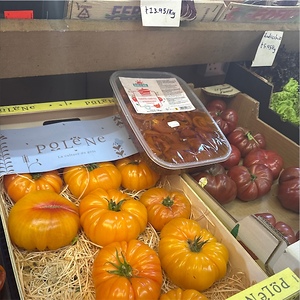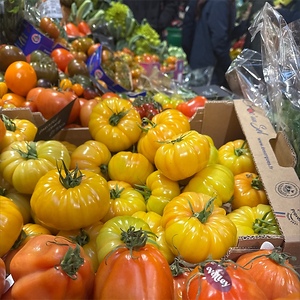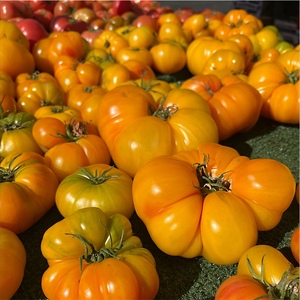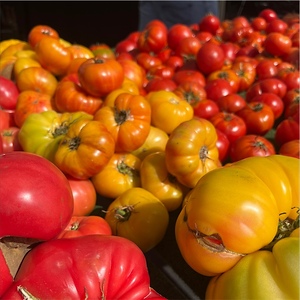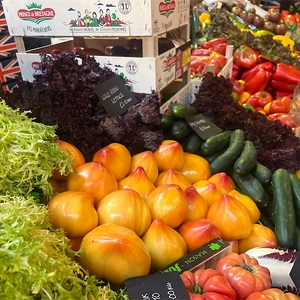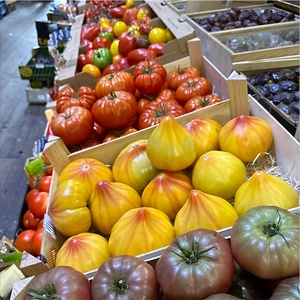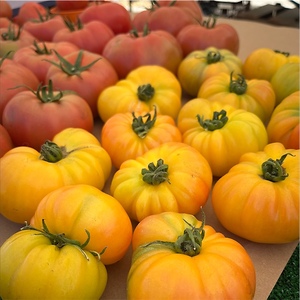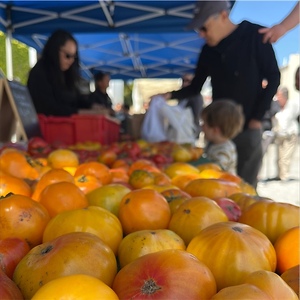

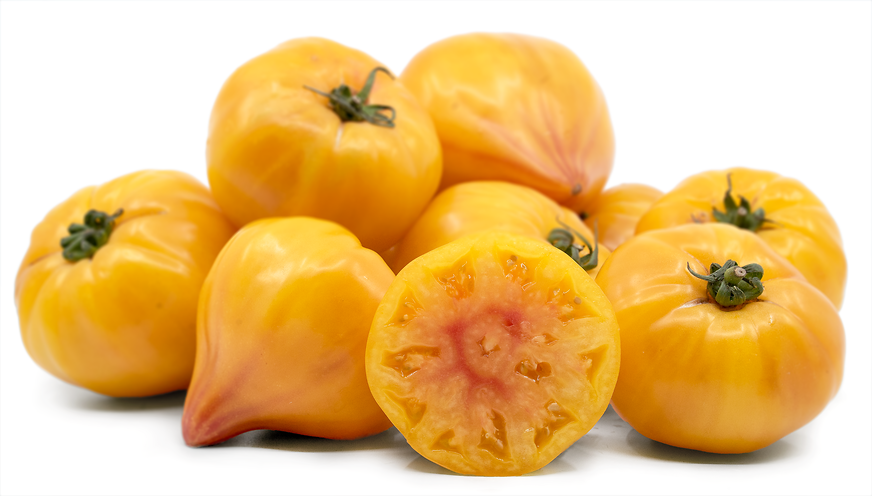
Pineapple Heirloom Tomatoes
Estimated Inventory, lb : 0
Description/Taste
Pineapple tomatoes are a beefsteak variety with a large, rounded body that typically measures between 13 and 15 centimeters wide and weighs about 680 to 910 grams. They have a puffy, flattened shape with deep ribbing transcending down from the spiky green stem to the bottom of the fruit. Pineapple tomatoes have a golden-orange skin with red-blushed marbling that appears as faint stripes. This thin, glossy skin has a smooth and firm texture. The fruit’s flesh shares the same sunny color, with a meaty, solid texture and a few seeds nestled within its red starburst center and gel pockets. Pineapple tomatoes have a strong tomato aroma, low acidity, and a primarily sweet, mild, and fruity flavor with a touch of citrus tang.
Seasons/Availability
Pineapple tomatoes are available from mid to late summer.
Current Facts
Pineapple tomatoes are botanically classified as Solanum lycopersicum and belong to the Solanaceae family, along with tobacco, potatoes, and petunias. These heirlooms are also referred to as Hawaiian Pineapple tomatoes because their ribbed exterior and flesh resemble a slice of pineapple. They are a yellow variety from the Pineapple tomato line that also includes Black, Blue, Green, Oxheart, Pineapple Pig, and Potato Leaf Pineapple tomatoes. Of all the Pineapple cultivars, the Yellow Pineapple is known to have the most detectable pineapple flavor. This variety grows on plants that can reach between 1.5 to 2 meters tall and about 60 to 92 centimeters wide. These plants often require staking or caging in order to encourage healthy growth and prevent garden sprawl.
Nutritional Value
The nutritional value of Pineapple tomatoes isn't widely known, but tomatoes are typically high in vitamins A and C, which are powerful antioxidants that support immune health, skin, and vision. Vitamin C also plays a crucial role in collagen formation, aiding in the maintenance of skin and connective tissues. Tomatoes contain potassium, a mineral essential for heart health, blood pressure regulation, and fluid balance in the body. These fruits are also a good source of dietary fiber, which supports digestive health, helps regulate blood sugar levels, and contributes to feelings of fullness. Tomatoes are particularly known for their lycopene content, a potent antioxidant that gives them their red color and is linked to lower risks of chronic diseases. Their lycopene content also promotes skin health and may provide protection against sun damage.
Applications
Pineapple tomatoes are best served raw but can also be grilled, baked, or stewed. They are known as a slicing tomato that’s often used in Caprese salads and sandwiches with fresh basil, mozzarella, and balsamic vinegar. This variety pairs well with bread and is commonly incorporated into burgers, flatbreads, pizzas, tarts, and bruschetta. Pineapple tomatoes may be mixed into salads, wraps, soups, pasta, lasagnas, chilis, and omelets. They complement proteins such as roasted chicken, hanger steak, cured mackerel, anchovies, and grilled octopus. This variety pairs well with fresh greens, basil, garlic, rosemary, thyme, olive oil, ricotta cheese, focaccia bread, peaches, white beans, hazelnuts, chickpeas, olives, salami, potatoes, truffles, ginger, onions, dill, feta cheese, pistachios, pesto, and okra. Pineapple tomatoes bruise easily so they should be used as soon as possible upon ripening. To maximize flavor, avoid refrigerating tomatoes unless they are extra ripe.
Ethnic/Cultural Info
Pineapple tomatoes are an heirloom developed by the Gleckler's Seedmen Company. This company was founded in 1947 by Merlin Gleckler in Metamora, Ohio. Glecker was an enthusiast of rare and unusual seed varieties, particularly heirloom tomatoes. When Glecker had to step down after having a stroke, his son George took the company in a new direction. With the help and funding of Seed Saver’s Exchange, George was able to revive many lost varieties and shift focus to pure, high-quality seeds and cultivars like Pineapple tomatoes. Despite competition from larger retailers, Gleckler's Seedmen Company continues to offer a wide range of open-pollinated seeds, beloved by gardeners with a passion for heritage heirloom varieties.
Geography/History
Pineapple tomatoes were developed by Gleckler's Seedmen Company in the early 1950s, likely in Kentucky. This variety flourishes in warm and hot climates with full sun exposure and growing temperatures ideally between 24 and 45 degrees Celcius. Pineapple tomatoes are a cultivated variety that’s sown by commercial farmers and home gardeners. These bi-colored tomatoes have grown in popularity as companies like Gleckler's Seedmen renew interest in heirloom types, including the Pineapple tomato and its vibrant color variations. Pineapple tomatoes were introduced into Europe in the mid-20th century and have since inspired the development of other hybrids, including the Black Pineapple, introduced in 2005. They remain a niche variety that may be primarily sourced in the United States from farmers’ markets or purchased from nurseries to grow from seeds.
Recipe Ideas
Recipes that include Pineapple Heirloom Tomatoes. One
| The Cozy Apron |
|
Crispy, Fried Heirloom Tomatoes |
| Foodie Crush |
|
Burrata and Heirloom Tomato Caprese Salad |
Podcast







